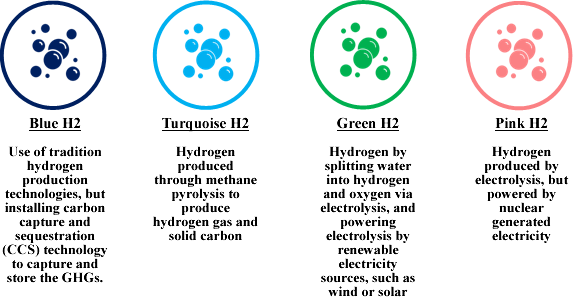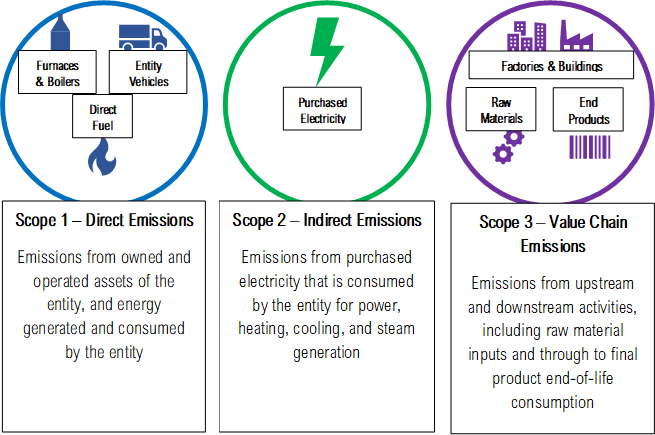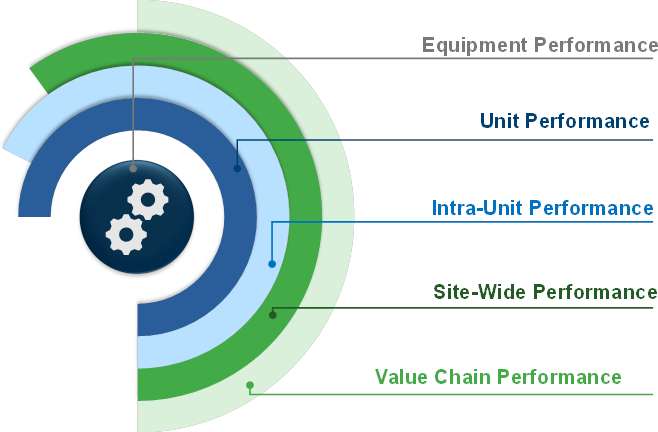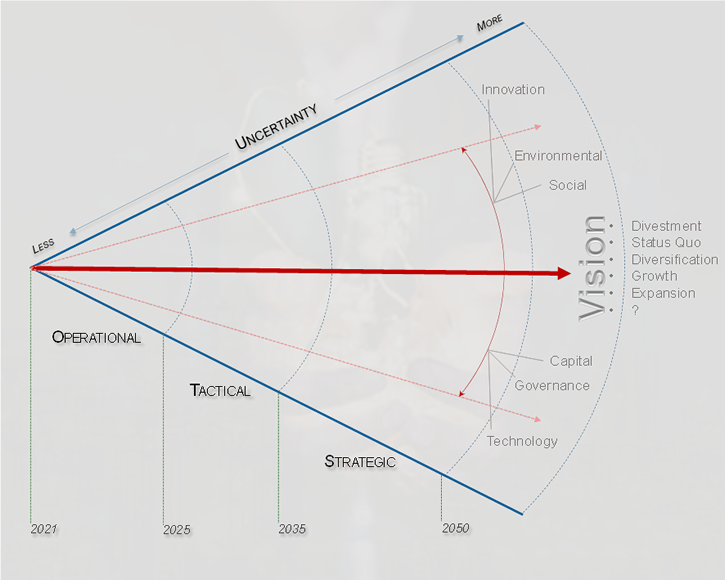First Principles of Energy Transition – An Unbiased Look at the Data and Principles: Part 2
Contributing authors: Jean-Gaël Le Floc’h, Mel Larson and Darren York
Energy Transition – Where do we go from here?
In part one of this two-part series, we examined the sheer magnitude of the energy transition change and how it will impact every part of our lives and economies. From there, we outlined some of the unintended consequences as well as the growth and expansion requirements within metals extraction, battery production, and overall electrical infrastructure to meet the shift away from traditional fossil fuels for transportation and power usage. In part two, we will focus on the application of hydrogen as a potential solution, along with the associated challenges, and review Scope 1, 2, and 3 emissions to understand what these mean for the Energy Industry and front-line consumer. Finally, we will close this series with some focal areas that the energy providers should consider as they develop their strategic, tactical, and operational plans to achieve their defined strategy.
Hydrogen – The Gas that Solves All Our Problems?
In these early days of energy transition, hydrogen has emerged as a lead option for addressing decarbonization, as it is a key building block and has many diverse applications within the energy sector. Currently, most hydrogen is produced by steam methane reforming or partial oxidation of natural gas, refinery off gases, LPG, and light naphtha (C5s and C6s). Both processes produce carbon monoxide and carbon dioxide that is sent to the atmosphere, resulting in these types of hydrogen being labeled as grey hydrogen. These production methods are being replaced by multiple alternatives that meet GHG emission reduction targets.

Presently, the bulk of hydrogen produced is used in the industrial sector, with a key consumer being refiners that utilize hydrogen to remove sulfur and nitrogen and increase the qualities of transportation fuels while also converting heavy hydrocarbons to more valueable products. The future vision is to utilize hydrogen in alternate ways – as a direct transportation fuel, as a source for heating and cooking, as a way to produce “green” transportation fuels, and as a way to store energy as well as generate electricity.
While hydrogen does have a key advantage that, when it is combusted, it does not produce carbon-based emissions (only water), hydrogen itself does have several challenges. For the sake of brevity, the use of hydrogen for fuel cells is reserved for a future discussion. Instead, we will focus on simple replacement of natural gas as a source of energy via combustion for electricity generation, cooking, and home heating uses. One challenge is that the energy density of hydrogen on a mass basis is quite high but is 1/3rd of natural gas heat value on a volume basis (~975 BTU/scf for typical natural gas and 273 BTU/scf for hydrogen). To demonstrate, let’s take a typical natural gas pipeline that supplies fuel to front-line consumers. Most conventional burners can handle 10 to 15% hydrogen before they require modification to manage operating pressure and combustion profile (think of the home grill that can be run on propane or natural gas but requires different burners and regulator). If 15 mol% hydrogen is used to replace natural gas within the pipeline, a few interesting shifts occur.
To deliver the same net BTUs out of the pipeline, the volume of gas must increase by around 12%, which may seem simple enough. However, the pipeline already exists and replacing that pipeline to handle this increase is not only capital intensive but also may require months of regulatory permits. In addition, the operating pressure of the pipeline must be increased, which may require re-rating and other modifications, additional compression stations may be required, and additional compression power is needed, to the tune of around 16%. Assuming this power is generated by green sources, additional power supply and infrastructure may be needed, and the pipeline compressors will need to be modified. In the extreme example, the pipeline with 100% hydrogen will required over 4 times the compression horsepower to meet the same energy delivery.
Hydrogen will certainly be part of the mix to meet energy demands and shows great promise. However, technical hurdles like these just touch the surface of what the energy industry must address. Hydrogen refueling stations will require extensive infrastructure installation, and transportation, storage, and shipping of hydrogen presents metallurgical, operating pressure, and process safety challenges. Conversion of hydrogen to high energy density liquid streams, such as ammonia, allows for re-use of existing combustion systems, especially in the shipping industry, but presents its own handling issues. Also, this option has its own challenges, for the same energy release as a fossil equivalent, 2.4 times as much ammonia is necessary, and pure ammonia burning typically exceeds current NOx emissions allowances. Leveraging of existing offshore infrastructure to convert wind energy to green hydrogen and using the gas lines to onshore infrastructure shows promise. Hydrogen, as a core building block, presents many opportunities for consideration as a solution for our energy needs.
What are Scope 1, 2, and 3 Emissions and How does one impact them?
Over the last several years, the terms of Scope 1, 2, and 3 emissions are used regularly within the energy production and consumption industries, but their definitions may not be clearly understood. As a brief history, the World Resources Institute (WRI) and World Business Council for Sustainable Development (WBCSD) first released a corporate standard in 2001 and, over the years, have continued to enhance and revise this standard as well as provide guidelines and tools for corporations, cities, countries, and energy sectors. Details can be found at ghgprotocol.org.
To understand these definitions, let’s first start with outlining which emissions are included. As expected, CO2 is at the core of carbon emissions, but other greenhouse gases like methane, nitrous oxide (N2O), hydrofluorocarbons (HFCs), perflurocarbons (PFCs), and others are also within the boundary. Therefore, when preparing balances for a given entity or looking for improvement opportunities, each of these areas should be explored.
The following graphic summarizes the definition and boundaries for Scope 1, 2, and 3 emissions.

Scope 1 and 2 are the emissions that most entities have a clearer understanding of accounting on, as they are often required for tracking and filing by regulatory entities and corporate mandates. These are the emissions that are created by the fuel and power that is consumed or purchased by a given entity to convert their raw materials to a final product for either processing by another entity or use by the final consumer. Therefore, whether it be the purchased electricity from the local power grid, use of natural gas or coal for steam and power generation by the plant directly, or the gasoline and diesel used by the vehicles associated with the entity, all these combine into the Scope 1 and 2 emissions.
Scope 3 emissions are more challenging to account for, as they relate to the entire energy required to produce and transport the raw material, as well as the raw material itself, and then the emissions created by the next processing entity through to the final product. To track, understand, and identify improvement opportunities, the entity must have a clear understanding of their entire value chain and the associated carbon footprint, which is no small feat. The trend continues to increase of those entities that are required to track and report these emissions.
Most energy companies and firms are beginning the process of identifying ways to improve and reduce Scope 1 and 2 emissions, especially those who have set substantial reduction targets by 2030 to 2035, as well as tracking and understanding their upstream and downstream Scope 3 emissions. To begin the process, a multi-layer and bi-directional process is recommended (see graphic). As with any entity, underlying performance starts at the equipment level. Therefore, measuring and tracking energy usage and identifying improvements must start here. Once the consumers and producers are clearly understood, one can move out several levels to the unit, intra-unit, and site-wide levels. For some organizations, these distinct levels may not exist, but within the modern refinery, petrochemical plant, or factory, multiple units must work together to produce the final product slate and having a clear understanding of their integration, both in process and energy, will illuminate improvement areas. Finally, with these levels and associated integration defined, the entity can evolve to examine the entire value chain to address Scope 3 emissions, both actual and potential improvement.

Though not an exhaustive list, the following areas can be considered as part of finding improvement opportunities:
- Replace existing natural gas, coal, and/or fuel oil with renewable fuel sources like green/blue hydrogen or biomethane/biogas, not only for fired heaters but also for gas turbine and cogeneration facilities.
- Examine heat integration opportunities, not only within process units but also between process units and sites
- Replace existing steam heating exchangers with process heat or electrical heaters and ensure live steam usage is at the optimal rates and pressure / temperature level
- Minimize flaring and steam venting
- Swap high carbon intensity raw materials for those raw materials with a renewable component, including processing of renewable vegetable oils and animal fats to product renewable diesel, gasoline, naphtha, and off-gas
- Examine opportunities to reduce transportation requirements and processing steps to reduce energy usage
- Ensure maximum potential heater efficiency through proper design and maintenance for fired equipment, as well as training for front-line operations staff on proper heater balancing and tuning
- Map out and evaluate the site wide steam and power cycle efficiency to examine opportunities to replace steam-based shaft work with electrical shaft work
- Diversify energy input and the product portfolio to create emissions off-sets
- Examine novel technologies for energy generation and production, as well as within the production value chain, to enhance efficiencies and leverage “green” opportunities
Examining opportunities like these in a holistic way can generate the forward path needed to meet ones Scope 1, 2, and 3 emission reduction targets.
How can the Energy Industry meet the challenge?
The examples in this two-part series provide just a few instances of the technical, economic, and social challenges the Energy Industry must address to meet global energy needs, remain viable, and attain the construct of reducing GHG emissions. To face these issues, energy suppliers must define and align their Strategic, Tactical, and Operational activities into an overall vision. First, the organization should clarify what their overall vision is for their entity – “stay in business”, grow, expand, diversify, or divest. This long-term point of view provides the “north star” to guide the organization. From there, a strategy can be developed to achieve that vision. Long gone are the days of just focusing on the next 5 to 10 years for strategic planning and project portfolio management. The energy transition will drive an inflection point in the 2030 to 2035 time frame for energy sources and production rates that requires a flexibility and dynamic responsiveness. Planning will no longer be “up and to the right” – one must account for the eventual shift in the market and associated infrastructure.

Yet with this focus on long term strategy, the need for effective near-term operational performance becomes more critical than ever. The existing assets must generate cash flow to fund future investments and demonstrate to corporate boards, “green” investment firms, and other influencers that the entity is viable and sustainable. The linkage between Strategy and Operational elements are the Tactical changes that an entity will undertake. The tactical decisions and execution on capital projects, investments, divestment, and acquisitions are the connectors that will enable the organization to meet the evolving shifts within the overall energy transition. As time windows shift and strategy becomes tactical and then operational, the entire process must evolve as technology disruptors, government mandates and incentives, consumer preferences, social and governance compliance, and innovation breakthroughs become apparent and take shape.
Defining a Way Forward
The energy industry has faced many economic, social, environmental, and safety tests over the last 100+ years, and the energy transition presents a trial like no other. As each entity works to address the multiple technical challenges, as highlighted in the examples provided, and aligns their strategic, tactical, and operational elements, these five critical questions provide a starting point to begin that journey:
- Does your business have a Point of View (POV) to manage the transition?
- Does your business have Operational, Tactical, and Strategic plans that align to that POV?
- What will your business do to maintain environmental, social, and economic “license to operate”?
- What steps will your organization take to attract capital and talent to maintain a viable enterprise?
- What contingencies are being considered to identify and agilely respond to the known “unknowns”?
By answering these questions and, as importantly, realizing that the responses may not be fully formed, one can become an active part in stewarding our industry through this transition and continue to supply the vital energy sources that are so critical to modern society.
References:
- “We Set the Standards to Measure and Manage Emissions.” Greenhouse Gas Protocol |, ghgprotocol.org/.
- Becht Research and Analysis
Becht has a wide spectrum of experience in energy transition and decarbonization. For more information, please click below:


